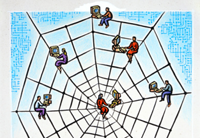
Update From Brett
Weaving an Organizational Spider Web

"Any act often repeated soon forms a habit; and habit allowed, steadily gains in strength. At first it may be like a spider's web, easily broken through, but if not resisted it soon binds us with chains of steel." - Tryon Edwards, American theologian, 1842. It is likely he never used wireless.
At the beginning of the school year, I challenged us to consider our responsibilities to the students of today and tomorrow. Now, in a flash, the academic year is half over and as I think about how we are doing with our focus on the academic mission, I think of spiders.
In a spider web, not every strand of silk is the same and I'm not just talking about the length or direction. I literally mean that spiders can produce more than one type of silk. Some strands are strong and intended for forming the weight-bearing superstructure of the web. Some strands are stretchy and intended to flex when the prey struggles. Some strands are smooth and help the spider move more easily around the web. Chemically different, each strand is coordinated and dependent on the others to do the totality of the job for which the web is intended.
Our approach to the academic mission mirrors that of spider web construction. We have a strong support structure in LearnLink, Blackboard, ResNet, learning spaces, and classroom support. But what sticky, stretchy, or smooth strands fill in the web? These are the unique connections we make with students in the course of their residential and academic life at Emory.
If a web is for catching things, do we catch our students at the right times and places? Do we help them acquire, process, recall, analyze, synthesize, utilize, and retain information in such a way that promotes real and lasting learning? I am always looking for more ways to re-imagine the way learning happens at Emory. I believe we have the competencies on our staff to address this learning, but do we make it happen here and now?
A snapshot of our current efforts yields mixed results. On the roadmap for this year is an upgrade to Blackboard. Notable more for the moderate number of "should be low risk" changes to infrastructure platforms than for the anticipated benefits of the new version, the detailed planning for this project hasn't happened fast enough to keep us on track. When it comes to planning, managers are on the hook for making sure they know what their staff is working on, even one or two months into the future. Moreover, they need to break through and crush territorial issues when they arise. So far, Blackboard is an example of a strong strand that is serving its basic purpose but probably taking more time and energy than it should.
One of our riskiest efforts in the student realm this year is the move to an enhanced wireless experience in ResNet. Following the creation of new wireless designs for four residence halls in December, permanent AP installations have begun. Unique to this project is a terrific example of innovation in how we grant and bill wired access for students after the halls go "all" wireless.
A team of Bruce Anderson (Infrastructure), Norman Butler (Infrastructure), Missie Martin (Integration), Paul Petersen (Infrastructure), and Alan White (Infrastructure) developed and implemented a way to use NetReg to present students with a signup screen that will activate their machine on any wired port in ResNet. What a great way to automate the registration process and give students service at the moment they request it! By comparison to Blackboard, the ResNet wireless project involves big risk, but with a big payoff for the tremendous amount of work we have already done. The return of the students will be our moment of truth.
Another project addressing the academic mission is Symplicity, which involves replacing the College's Advising and Tutor tracking software with a common application while also pulling in the School of Nursing and Oxford. José Rodriguez (Academic Technology Services) is leading this project, which provides a hosted solution for the management of student affairs. It's attractive because it is relatively inexpensive and has a variety of communication features that can integrate with most student communication channels, including Facebook. Symplicity offers a holistic view into the undergraduate population and helps administrators identify and track at-risk students along a variety of dimensions much more ably than before.
Our efforts with Blackboard, ResNet wireless, and Symplicity directly address our academic mission, but they are still representative of the broad and guiding superstructures of our web. And if the center of the web is the individual attention that students get from ECIT or individual contact from staff in Cox Hall, then we still have a chance to complete the web, making it stronger and more effective. Mass individualization of instructional modalities, deep data mining of student experiences, and establishing a broader reach of work with faculty in their unique use of technology are all opportunities left for us to work on this year.
- Brett Coryell, Deputy CIO, OIT